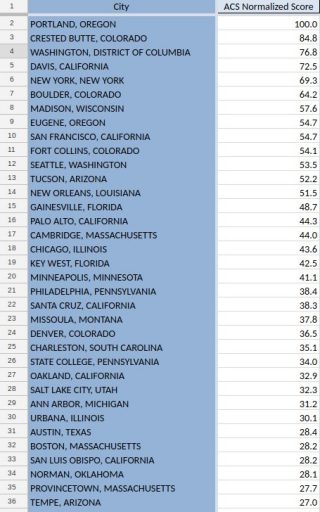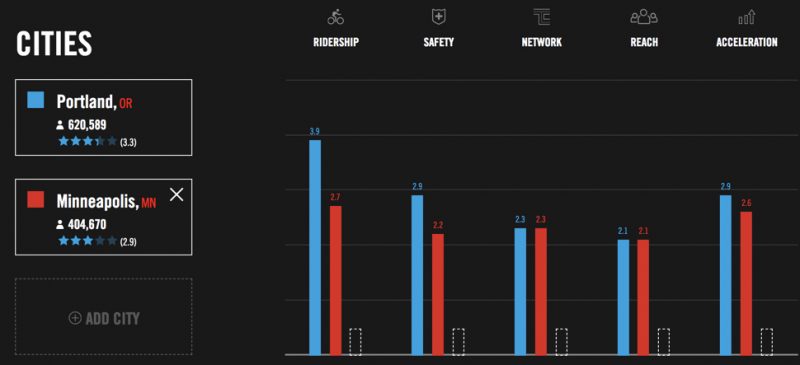
The world of bike wonks is abuzz this morning as national nonprofit advocacy group People for Bikes has released their much-anticipated city ratings. And Portland fared quite well with a score of 3.3 out of 5 that puts us first among big cities and fourth overall. A total of 480 cities were part of the analysis.

(Photo: Roger Geller)
Among big cities, the ratings put Tucson, Arizona; Madison, Wisconsin; Washington D.C.; and San Diego, California in the top five along with Portland.
In addition to our good showing in the ratings, Portland was given a special award for having the highest “ridership score” of any city — a 3.9. According to People for Bikes, Portland earned a perfect score of 100 in this ridership metric, in large part because it takes distance into account. “Contrary to some local narratives,” they shared on Twitter this morning. “Portland is truly extraordinary in the amount of bike commuting that happens far from its core.”

PFB Staff Writer Michael Andersen explained this further in a blog post about the ratings:
“Instead of comparing bike commuting rates the simplest possible way — the percentage of workers who live within city limits who report commuting mostly by bike on a random week — it introduces a much smarter way to weigh commuting rates against each other.
First, the method doesn’t penalize cities like New York or Boston for having lots of transit or foot commuting. Instead of measuring bike commuters as a share of all commuters, it compares bike commuters to the number of car commuters.
Second, the method doesn’t penalize cities like Indianapolis or Tucson for having far-flung city limits that happen to include suburban-style neighborhoods.
… But in the best bike cities, distance from the “biking core” matters less. We score cities not only by how much biking there is their core, but also how much biking there is one mile away, two miles away and so on. This removes city borders as a factor.”
These new ratings are unlike anything the bike advocacy world has seen before. In the past, the only rankings systems anyone paid much attention to were the Bicycle Friendly City designations (where we got “Platinum” in 2008) and statewide rankings from the League of American Bicyclists (where Oregon placed sixth in 2015), Bicycling Magazine’s “Best Bike City” issue (which lost all credibility when it took Portland’s #1 ranking away in 2010 just to sell more magazines), and, to a lesser extent, the “Bike Score” rankings from Walk Score.
People for Bikes’ (PFB) city ratings (a program funded by Trek Bicycles) look to be the most comprehensive and data-driven analysis yet. They are also the most transparent, which means anyone can delve deeper into the methodology and the raw numbers to find out how the sausage was made — and more importantly, what it would take to boost a rating.
The ratings were determined on a five-point scale across five major factors: Ridership, Safety, Network, Reach and Acceleration. Here’s how each of them is defined:
Advertisement
RIDERSHIP
The Ridership score reflects how many people in the community ride bikes. It considers biking for both recreational biking and biking for transportation. Data Sources: ACS, SMS, Community SurveySAFETY
The Safety score considers fatalities and injuries of people on bikes as well as those walking and driving. Perceptions of safety are also given weight. Data Sources: FARS, Community Survey, City SnapshotNETWORK
The Network score evaluates the quality of the bike network — how completely it connects people to each other and local destinations using comfortable routes. Perceptions of the network are also given weight. Data Sources: BNA, Community SurveyREACH
The Reach score determines how well a community’s low-stress network serves all members of the community. It uses demographic data to understand differences in access and connectivity for traditionally underserved populations compared to the whole city. Data Sources: ACS, BNAACCELERATION
The Acceleration score assesses how quickly a community is improving its biking infrastructure and how successful its encouragement programs are at getting people to ride. Data Sources: City Snapshot, Community Survey

Since PFB’s core mission is to improve bicycling in America, the rating system is targeted at agency staff and planners who want a tangible metric to help make decisions and track progress (or lack thereof) year-over-year.
In addition to using existing datasets, PFB input qualitative insights gleaned from thousands of surveys filled out by riders from every city. A total of 187 data points per city went into the overall scores. PFB has a full-time data researcher (Jennifer Boldy, Ph.D, the former president of Breakaway Research Group) on staff who has worked on this project since being hired two years ago.
The ratings are complemented with a useful website where you can sort cities by all metrics (including population) and even choose three cities for head-to-head comparisons (yes we beat Minneapolis, thank you very much).
PFB unveiled the listings at their annual Places for Bikes conference which wraps up today in Indianapolis. Portland Bureau of Transportation Bicycle Planner Roger Geller was in Indianapolis this week to learn more about the ratings and accept our awards.
If you’re so inclined, I recommend taking a closer look at the methodology to learn more about the analysis that went into these ratings. PFB says they plan to crunch the numbers every year.
— Jonathan Maus: (503) 706-8804, @jonathan_maus on Twitter and jonathan@bikeportland.org
Never miss a story. Sign-up for the daily BP Headlines email.
BikePortland needs your support.

